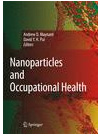| Posted: January 16, 2007 |
Research advances on nanotechnology workplace health and safety |
|
(Nanowerk News) "Companies, workers and investors alike are being challenged by the uncertainties surrounding nanotechnology workplace safety. These uncertainties include lack of sound, scientific information on occupational risks, poorly determined perceptual risks, and hesitancy over nanotechnology oversight," according to co-authors Andrew Maynard and David Y.H. Pui in an article in the latest issue of the Journal of Nanoparticle Research. This is a special journal issue devoted to nanoparticles and occupational health.
|
|
"Workers are society's canaries-in-the-coal mines when it comes to the environmental, health and safety effects of new materials--and nanoscale materials are no different," said Maynard, chief scientist of the Woodrow Wilson Center's Project on Emerging Nanotechnologies.
|
|
"The good news is that international concern over how to ensure safe nanotech workplaces has resulted in some progress. The bad news is that critical questions about worker safety--and about broader environmental, human health and safety issues--remain unanswered," stated Maynard.
|
|
Areas of specific progress that Maynard and the University of Minnesota's Pui highlight in their article include new instrumentation capable of better measurement of airborne nanostructured particles, innovative ways of controlling exposure to airborne nanoparticles, and the effectiveness of filters in removing nanometer-diameter particles from the air. Reports on these advances are included in the Journal of Nanoparticle Research special issue published in January 2007 by Springer.
|
|
In less than a decade, nanotechnology is predicted to result in $2.6 trillion in manufactured goods annually. Already, there are almost 400 manufacturer-identified nanotechnology-based consumer products on the market--ranging from computer chips to automobile parts and from clothing to cosmetics and dietary supplements. See: www.nanotechproject.org/consumerproducts. Lux Research estimates the number of jobs involved in making nano-enabled products will rise from about 50,000 today to more than 10 million in 2014.
|
|
"Little is known about potential risks in many areas of nanotechnology--and funding for risk-focused research is a small fraction of the nearly $10 billion spent annually by governments and industry on nanotechnology commercial applications. Greater resources and attention are needed now on nanotechnology occupational health and safety research in order to ensure safe nano-workplaces today and in the future," said Maynard.
|
|
Andrew Maynard is an internationally recognized leader in the fields of aerosol characterization and the implications of nanotechnology to human health and the environment. Before he joined the Wilson Center in 2005, Dr. Maynard worked at the National Institute for Occupational Safety and Health (NIOSH), part of the U.S. Centers for Disease Control and Prevention (CDC), where he was instrumental in developing NIOSH's nanotechnology research program.
|
|
Dr. David Y.H. Pui is a well-known researcher and Distinguished McKnight University Professor at the University of Minnesota's Department of Mechanical Engineering. Pui has approximately 250 publications in the field of aerosol science and technology, including studies on nanoparticle production, measurement, and filtration.
|
|
A hardbound copy of this special issue of the Journal of Nanoparticle Research will be available in book format, Nanoparticles and Occupational Health. It is scheduled for release on February 1st.
|
 |

